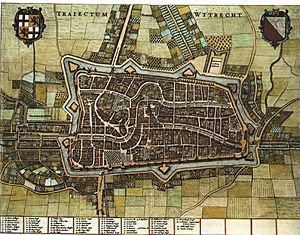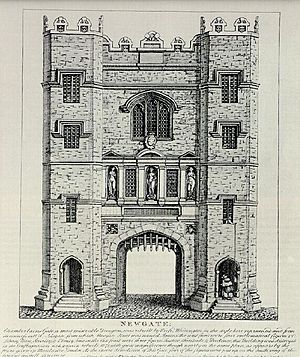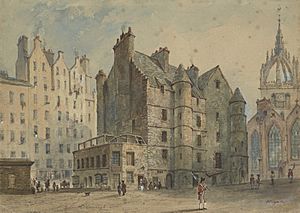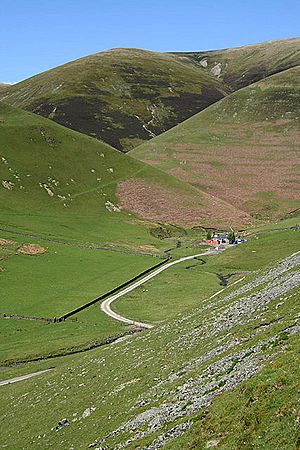Alexander Shields facts for kids
Quick facts for kids Alexander Shields |
|
|---|---|
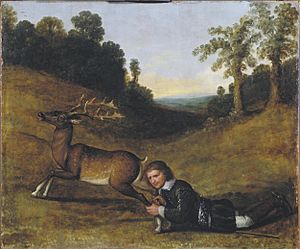
Shields' most famous work is A Hind Let Loose. This refers to the words in Genesis 49, v21 : "Naphtali is a hind let loose" and is a prophecy about that tribe of Israel. Shields was on the stairs preaching on this passage about "the excellency of the blessing of liberty" when he was arrested in London.
|
|
| Religion | Christianity |
| School | Presbyterianism |
| Personal | |
| Born | 1661 |
| Died | 1700 (aged 38–39) Port Royal, Jamaica |
| Resting place | unknown |
| Senior posting | |
| Title | Mr. (he was a graduate) |
| Religious career | |
| Profession | Preacher |
Alexander Shields (born in 1661, died in 1700) was an important Scottish minister, writer, and activist. He was a Presbyterian, which is a type of Protestant Christian faith. Shields was known for speaking out against unfair rulers and for people's freedom.
He was put in prison several times for holding private church services, which were not allowed at the time. After escaping, he wrote a famous book called A Hind Let Loose. This book talked about people's right to stand up to unfair governments. Shields also supported a group called the Cameronians, who disagreed with the king.
Later, after a big change in Scotland called the Revolution, Shields became a chaplain for King William's army. He even served in battles in the Low Countries. He then became a minister in St Andrews, Scotland. However, he soon joined a journey to a place called Darien (in what is now Panama). This trip was not successful, and Shields sadly died in Jamaica before he turned 40.
Contents
Early Life and Education
Alexander Shields was born in 1661 in Earlston, Scotland. His father, James Shields, was a miller. Alexander went to the University of Edinburgh and finished his studies when he was only 15 years old in 1675.
He started studying to become a minister. However, he disagreed with the way the church was being run, especially with bishops having too much power. Because of this, he moved to Holland in 1679. He continued his studies at the University of Utrecht in 1680.
Time in London
After his studies, Shields returned home and went to London. He worked as a private secretary for a well-known religious leader, John Owen. This helped him connect with other important Puritans, who were Protestants who wanted to make the church simpler.
Scottish Presbyterians in London allowed Shields to become a preacher. However, he refused to take an oath of loyalty to the king, as he was a Covenanter. Covenanters were people who had signed agreements to protect their Presbyterian faith.
In 1685, Shields was arrested while preaching at a private church meeting in London. He was preaching about "liberty" from a passage in the Bible. He was taken to Newgate Prison.
Imprisonment in Scotland
Shields was sent to Scotland without a trial in England. He arrived in Leith in March 1685. He was questioned by Scottish officials but refused to answer their questions directly.
Under threat of torture, he eventually signed a paper. This paper said he would give up any past agreements that declared war against the king. Even though he signed it, he was still kept in prison.
A letter he wrote, saying he regretted signing the paper, was found by the authorities. He was questioned again and sent to the Bass Rock, which was a prison island. Shields managed to escape from the Bass Rock by dressing in women's clothes in late 1686.
After His Escape
After escaping, Shields quickly joined James Renwick, another important Covenanter leader. They met at a private church gathering in December 1686. Shields publicly said he was sorry for having signed the paper that seemed to support the king's authority.
Shields' famous book, A Hind Let Loose, supported Renwick's views. Shields also helped publish another important Covenanter document. He traveled to Holland to get it printed and to finish his own book.
After Renwick was executed in 1688, Shields became the main leader of the United Societies, a group of Covenanters. He continued to hold outdoor church meetings, even though they were dangerous. He was also involved in actions where Covenanters removed ministers they didn't agree with from churches in western Scotland.
After the Revolution
After the Revolution in 1688, the Presbyterian Church was re-established in Scotland. Shields and his friends, Thomas Lining and William Boyd, joined the Church of Scotland in 1690.
They presented some requests to the church assembly, asking for changes and explaining their past actions. Their requests were accepted, and they were welcomed into the church. In 1691, Shields was made a chaplain for the Cameronian regiment, a military group.
He served with the army in the Netherlands and was present at important battles like Namur and Steinkerk. When peace was made, he returned to Scotland. He became a minister in St Andrews in 1697.
The Darien Expedition
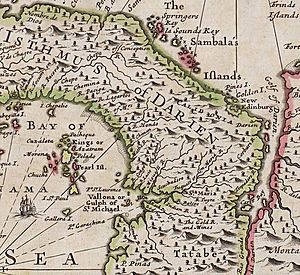
In 1699, Shields was chosen to go on the second Darien expedition. This was a plan by Scotland to set up a trading colony in Darien, in what is now Panama. He sailed with three other ministers and many colonists.
They arrived in Darien in late 1699. Shields was the senior minister. He wrote a letter describing the difficulties and the bad behavior of some colonists. He also mentioned trying to teach the local people, but without much success due to language barriers and the colonists' actions.
Shields explored inland a bit. Eventually, he and another minister sailed to Jamaica. Sadly, soon after arriving, he caught a fever and died on June 14, 1700, in Port Royal, Jamaica. He was less than 40 years old. His burial place is unknown.
His Character and Writings
People described Shields as a small man with a quick mind. He was very passionate about his beliefs and was good at arguing. He was also very knowledgeable.
Shields' most famous book, A Hind Let Loose, is divided into two parts. The first part tells the history of the Scottish Church. The second part discusses important questions of his time, such as:
- Why people should not obey unfair rulers.
- Why people should not take unfair oaths.
- Why private church meetings were important.
- Why people had the right to defend themselves.
- Why people could refuse to pay unfair taxes.
Another book he wrote, An Enquiry into Church-Communion, encouraged different groups of Presbyterians to unite within the Church of Scotland after the Revolution.
Works
Shields published several works during his lifetime:
- A Hind Let Loose (1687) – His most famous book, defending the rights of people to resist unfair rule.
- An Elegie upon the Death of … J. Renwick (1688) – A tribute to James Renwick.
- A Short Memorial of the Sufferings … of the Presbyterians in Scotland (1690) – About the hardships faced by Presbyterians.
Some of his works were published after he died:
- Church Communion enquired into (1706) – Arguing for unity within the Church of Scotland.
- The Life and Death of … James Renwick (1724) – A biography of James Renwick.


